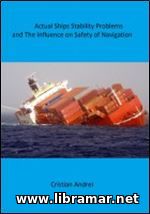 The present book is very important and useful because of the approach applied by the author to the problems relating to the loss of ship stability by means of the study of different operational aspects together with the dynamic ship behavior in severe condition of the sea and offering a complete picture of the selected modes of stability failure not currently covered by any criteria or applicable regulation.
The original motivation for the idea that has driven subject approach and the requirement to address the assessment of the ship stability is coming from numerous observations on losses of stability and capsizing of the ships. Though there are several regulations in force that all refer to the stability of the vessels, so many ships continue to loss their stability and capsize.
The subjects elucidated within this volume represent parts of the works relating to the critical importance of the assessment of ship stability and fit into the complex research system relating to the intact stability of the vessels, and particularly to the failure modes and how the proper assessment of the stability might prevent the possible losses. Five chapters of the book provide the general information and provide the historical background and analysis, cover the failure modes including ones in the severe conditions, and shed some light on the possible improvement in the field.
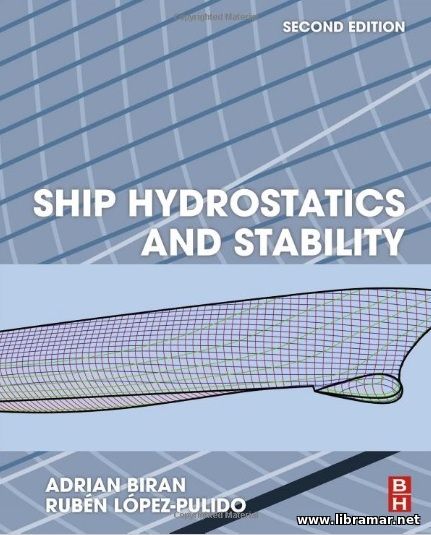 Here is the second edition of this book which continues to serve as one of the most complete and comprehensive guides to proper understanding of the ship hydrostatics together with the associated design and performance matters, taking readers from the basic principles to the serious and detailed analysis.
The practical application of the hydrostatics has been illustrated using the real-life examples and calculations conducted in Excel and MATLAB programs. Apart from the traditional content, this release of the book includes the definitions and also indexes presented in four languages in order to make the material accessible to the international readers.
As always, the book is equipping the naval architects with the required theoretical knowledge and context to get the understanding oh the stability through all stages from design to the construction and use, it is covering the pre-requisite basic theory including the dimensions and geometry of the ship's hull, calculation of moments and numerical integration, and it is outlining a clear approach to the modeling of stability and its analysis my means of the contemporary methods of computation, covering the international recognized standards and applicable regulations governing the stability. An excellent publication which have deservedly gained the world popularity and recognition among both students and specialists.
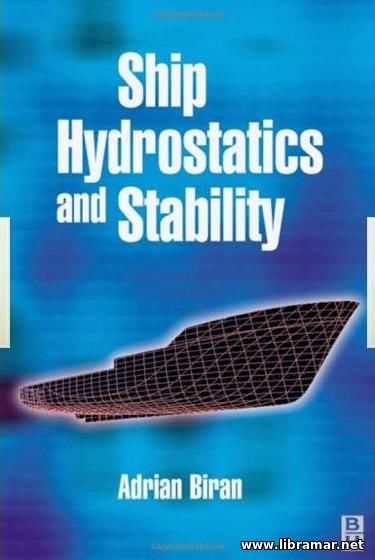 The hydrostatic approach applied to the problem of ship stability intends to find a due balance of the idealized weight of the ship and buoyancy forces acting on the hull. The present textbook may be treated as a complete guide book to be used by the students and even professionals willing to get better understanding of the ship hydrostatics in the design and performance of the vessels.
The author of the volume is bringing the readers from the first fundamental principles through both basic and applied theory of hydrostatics and ship stability, and he is also introducing the modern and newly presented mathematical techniques used for hydrostatic modeling and analysis. Numerous real-life examples have been included in the book to show the practical application of the hydrostatics and explain the theory and calculations; they will also help to demonstrate the effects of the shifting weights and displacements of the central gravity on the overall stability of the vessel.
The content of the book addresses all recent developments in naval architecture, for example the Matthieu effect relating to the parametric resonance, influence of the ship lines, effects of nonlinear ship motions on stability, and the international regulations governing the stability of the small vessels with the extensive use contemporary computer techniques...
 People interested in contemporary ship stability are aware that luckily some significant progress has been attained in ship stability during last couple of decades. However, there are still some challenges that require proper input, such as the accurate prediction of the capsize dynamics and extreme motions of the vessels, both in intact conditions and damaged.
Among such challenging areas we would also mention the probabilistic nature of the extreme events, various criteria reflecting both physics and operational safety of the vessels, and ways of providing all relevant technical information on the safe handling of ships. The present title is intended to give readers an exceptionally comprehensive and thorough review of all above stated issues by selecting the representative documents presented in the course of several international conferences and workshops on stability.
The list of topics covered within this publication includes the stability criteria and intact ship stability, parametric roll and broaching-to, roll damping, non-linear dynamics and probabilistic assessment of capsizing, environmental modeling. design for the ship safety, naval vessel stability, application of the CFD, i.e. computational fluid dynamics, methods to the stability, and investigation of the accidents involving ship capsizing. In short, the book contains professional articles formally presented by the world leaders in the field of stability.
 A very useful and informative self-contained reference publication containing the data on the added mass not only of the ships but also of the various other marine engineering structures. The author has provided a good description of both theoretical and experimental methods of determination of the added masses. The volume will impress readers with the completeness and width of the content together with the consistency of presentation of the material.
It will definitely be found extremely practical in the everyday work. Note that this book may be used in ship engineering as well as in various other fields of engineering such as machine engineering and hydrotechnique. The author has made a good attempt to summarize all important material published earlier in English and Russian-language literature sources. Proper knowledge and understanding of the added masses interacting with the fluid is considered necessary in the research and applied tasks.
The publication will definitely be called for by the ship designers as well as designers of all other engineering structures that commonly interact with the fluids. It will become a truly indispensable source of technical information. The author of the book has managed to combine numerous diverse issues relating to the determination of the added masses...
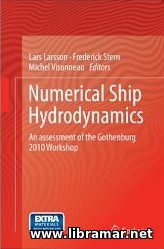 The present title was specifically released to assess the current situation in the field of the CFD, standing for the computational fluid dynamics, applied to the hydrodynamics of vessels; it is also intended to provide all specialists in this area with the required technical guidance to be used to the future developments. The main content of this volume is based on the materials presented during the stability workshop held in 2010 in Gothenburg.
The book is presenting the test cases as well as the data collected during the experiments and various computational methods. The publication also contains detailed analysis of the errors for local and global flow variables, including the standard deviations for the global variables and also propeller modeling for the self-propulsion. The authors of the materials contained in the book have also evaluated the effects of the grid size and also turbulence models and conducted the thorough analysis of the turbulence modeling capabilities to capture the physics of the local flow.
They have used the resistance submissions for evaluation of the errors and uncertainties using the systematic V&V, i.e. verification and validation, study together with the statistical investigations. Moreover, they have also analyzed all related computational and experimental studies...
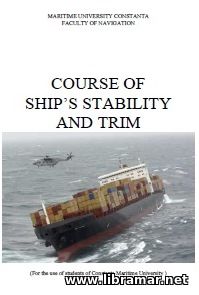 An excellent course to be checked by all students of naval architecture. The book was prepared and published by the Maritime University Constanta. The main content of this publication has been divided into numerous sections. The first section of the book addresses the basic principles and introduces the students to the laws that are commonly governing the flotation and this information will help them understand why the vessels float at all; the information provided in this opening section will help in forming the very basic level of knowledge required to complete subject training program. It is followed by the sections addressing the form coefficients of the ship's hull, TPC, Load Lines, basic introduction to the transverse stability, conditions of stability, effect of the free surface on stability, centre of gravity, list and trim, centre of buoyancy, GZ curves and suspended weights.
The remaining sections of the book are dealing with the stability criteria, wall-sided formula, inclining test, ice acceleration, wind heeling, curves of statical stability etc. Some of the practical problems of ship loading have also been covered, together with the international regulations, e.g. IMO Grain Code. At the very end of the book there is an illustrative example of the Stability Information & Tank Sounding Book that can be used for ready and easy reference.
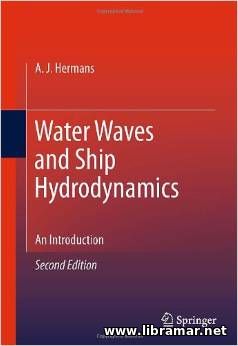 This book was written by A. Hermans with the intention to provide readers with a general technical introduction to the various aspects of the water waves playing the important roles in hydrodynamics of ships as well as offshore engineering. Firstly, it derives the equations and linearized boundary conditions that describe the non-viscous free waves with the particular attention being paid to the combination of non-steady and steady flow fields.
After that, the author derives some of the simple types of free wave solutions, for example cylindrical and plane waves. The source singularity function has also been derived for several steady and unsteady situations; subject functions are playing a role in the numerical codes that are used for the description of the ship's motion. The content of the publication is divided into eight major chapters addressing the water waves theory, second-order theory, non-linear and irregular waves, linear wave phenomena and asymptotic formulation, and other important technical aspects of the ship hydrodynamics.
The appendices at the last part of the book are providing such important additional information as the methods of characteristics and of stationary phase, two-dimensional Green's function, singular integral equations and simplification of the relevant algebraic equations. A very useful and practical volume for ship designers.
« 1 2 ... 4 5 6 7 8 9 10 » |







